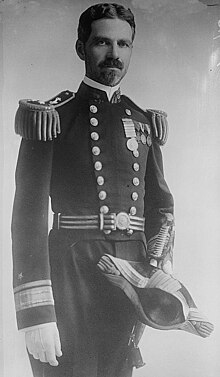Nathan Crook Twining: Difference between revisions
Added biographical information |
→Biography: moved paragraph |
||
| Line 27: | Line 27: | ||
Twining was born in [[Boscobel, Wisconsin]], on 17 January 1869, the son of Nathan Crook Twining (sr.) (1834–1924) and his second wife, Mary Jane Rennie. He was raised, in part, by his father's third wife, Margaret E. "Maggie" Rockwell (1849–1919) of Batavia, Kane County, Illinois. |
Twining was born in [[Boscobel, Wisconsin]], on 17 January 1869, the son of Nathan Crook Twining (sr.) (1834–1924) and his second wife, Mary Jane Rennie. He was raised, in part, by his father's third wife, Margaret E. "Maggie" Rockwell (1849–1919) of Batavia, Kane County, Illinois. |
||
He was appointed a naval cadet in 1885 and graduated from the [[United States Naval Academy]] on 7 June 1889. During the [[Spanish–American War]], he served in {{USS|Iowa|BB-4|3}} in [[Cuba]]n waters and later was executive officer of {{USS|Kearsarge|BB-5|3}} when that ship circumnavigated the globe with the [[Great White Fleet]]. |
He was appointed a naval cadet in 1885 and graduated from the [[United States Naval Academy]] on 7 June 1889. During the [[Spanish–American War]], he served in {{USS|Iowa|BB-4|3}} in [[Cuba]]n waters and later was executive officer of {{USS|Kearsarge|BB-5|3}} when that ship circumnavigated the globe with the [[Great White Fleet]]. |
||
In 1911, all the world's navies were concerned about the threat of airships bombarding |
In 1911, all the world's navies were concerned about the threat of airships bombarding warships. To counter this threat, Twining developed the US Navy's first anti-aircraft cannon to counter the airship threat. The prototype was a 1-pounder and while not placed in production, was used as the concept for the upscale [[3"/23 caliber gun|3 inch anti-aircraft cannon]] mounted on most US warships during World War I.<ref>[http://books.google.com/books?id=-t0DAAAAMBAJ&pg=PA776&dq=Popular+Mechanics+Science+installing+linoleum&hl=en&sa=X&ei=y4zsT9OSGMriqAGU1PW8BQ&sqi=2&ved=0CDYQ6AEwAA#v=onepage&q&f=true "New American Aerial Weapons"] ''Popular Mechanics'', December 1911, p. 776.</ref> |
||
He commanded {{USS|Tacoma|C-18|3}} during the [[United States occupation of Veracruz|bombardment of Veracruz]], [[Mexico]] in 1914. |
|||
During [[World War I]], he served as Chief of Staff for Admiral [[William Sims]], Commander of Naval Forces in European waters, and was also a member of the [[Allied War Council]]. |
|||
Rear Admiral Twining retired early in 1923 due to ill health.<ref>{{cite news |author= |coauthors= |title=Twining Quits Naval Berth. Admiral's Retirement Due to Ill Health. Other Changes Provided in New Orders. Battle Fleet Chaplains to be Switched |url=http://pqasb.pqarchiver.com/latimes/access/320373702.html?dids=320373702:320373702&FMT=ABS&FMTS=ABS:AI&type=historic&date=Jan+13,+1923&author=&pub=Los+Angeles+Times&desc=TWINING+QUITS+NAVAL+BERTH&pqatl=google |quote=Rear Admiral Nathan Crook Twining, chief-of-staff of the Pacific Fleet under Amiral Hugh Rodman and one of the most brilliant officers in the service, has boen ordered home and relieved of all active duty by recent naval orders. |work=[[Los Angeles Times]] |date= |accessdate=2010-11-23 }}</ref> He died on July 4, 1924 in [[Nantucket, Massachusetts]].<ref>{{Cite DANFS | title = Twining| url = http://www.history.navy.mil/danfs/t10/twining.htm| link=off| accessdate = 22 November 2010}}</ref> |
|||
==Family== |
==Family== |
||
Revision as of 15:48, 27 December 2015
Nathan Crook Twining Jr. | |
|---|---|
 | |
| Born | January 17, 1869 Boscobel, Wisconsin |
| Died | July 4, 1924 (aged 55) Nantucket, Massachusetts |
| Place of burial | |
| Allegiance | |
| Service | |
| Years of service | 1885–1923 |
| Rank | Rear Admiral |
| Commands | Tacoma |
| Battles / wars | Spanish–American War Occupation of Veracruz World War I |
| Relations | Merrill B. Twining & Nathan Farragut Twining (nephews) |
Nathan Crook Twining (17 January 1869–4 July 1924) was a rear admiral of the United States Navy.
Biography
Twining was born in Boscobel, Wisconsin, on 17 January 1869, the son of Nathan Crook Twining (sr.) (1834–1924) and his second wife, Mary Jane Rennie. He was raised, in part, by his father's third wife, Margaret E. "Maggie" Rockwell (1849–1919) of Batavia, Kane County, Illinois.
He was appointed a naval cadet in 1885 and graduated from the United States Naval Academy on 7 June 1889. During the Spanish–American War, he served in Iowa (BB-4) in Cuban waters and later was executive officer of Kearsarge (BB-5) when that ship circumnavigated the globe with the Great White Fleet.
In 1911, all the world's navies were concerned about the threat of airships bombarding warships. To counter this threat, Twining developed the US Navy's first anti-aircraft cannon to counter the airship threat. The prototype was a 1-pounder and while not placed in production, was used as the concept for the upscale 3 inch anti-aircraft cannon mounted on most US warships during World War I.[1]
He commanded Tacoma (C-18) during the bombardment of Veracruz, Mexico in 1914.
During World War I, he served as Chief of Staff for Admiral William Sims, Commander of Naval Forces in European waters, and was also a member of the Allied War Council.
Rear Admiral Twining retired early in 1923 due to ill health.[2] He died on July 4, 1924 in Nantucket, Massachusetts.[3]
Family
Twining was the uncle of United States Air Force General Nathan F. Twining, and United States Marine Corps General Merrill B. Twining. Rear Adm. Twining was married to Caroline Twining. Caroline died October 14, 1943, and is buried next to her husband.
Honors
In 1943, the destroyer USS Twining (DD-540) was named in his honor.
References
- ^ "New American Aerial Weapons" Popular Mechanics, December 1911, p. 776.
- ^ "Twining Quits Naval Berth. Admiral's Retirement Due to Ill Health. Other Changes Provided in New Orders. Battle Fleet Chaplains to be Switched". Los Angeles Times. Retrieved 2010-11-23.
Rear Admiral Nathan Crook Twining, chief-of-staff of the Pacific Fleet under Amiral Hugh Rodman and one of the most brilliant officers in the service, has boen ordered home and relieved of all active duty by recent naval orders.
{{cite news}}: Cite has empty unknown parameter:|coauthors=(help) - ^ "Twining". Dictionary of American Naval Fighting Ships. Navy Department, Naval History & Heritage Command. Retrieved 22 November 2010.
